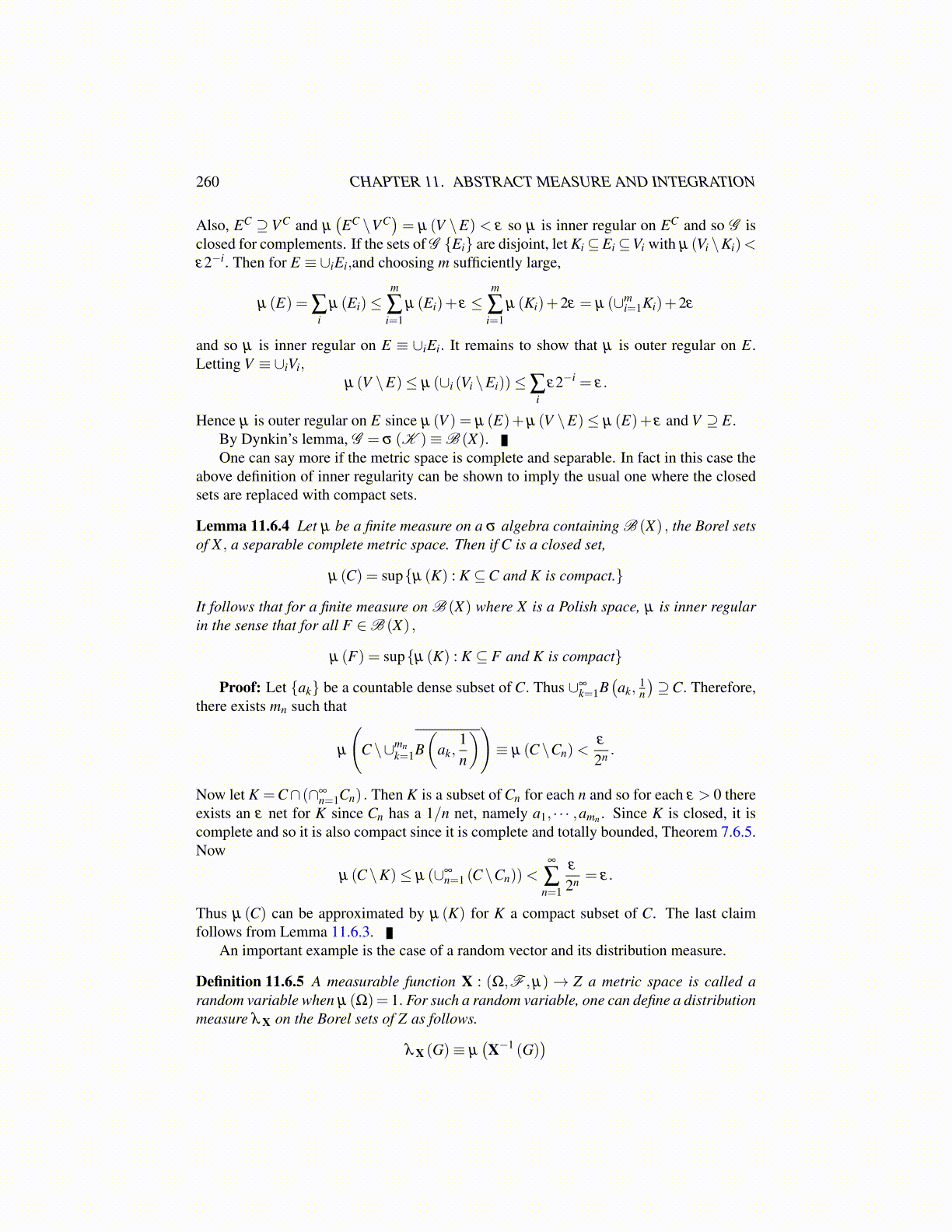
260 CHAPTER 11. ABSTRACT MEASURE AND INTEGRATION
Also, EC ⊇ VC and µ(EC \VC
)= µ (V \E) < ε so µ is inner regular on EC and so G is
closed for complements. If the sets of G {Ei} are disjoint, let Ki⊆Ei⊆Vi with µ (Vi \Ki)<ε2−i. Then for E ≡ ∪iEi,and choosing m sufficiently large,
µ (E) = ∑i
µ (Ei)≤m
∑i=1
µ (Ei)+ ε ≤m
∑i=1
µ (Ki)+2ε = µ (∪mi=1Ki)+2ε
and so µ is inner regular on E ≡ ∪iEi. It remains to show that µ is outer regular on E.Letting V ≡ ∪iVi,
µ (V \E)≤ µ (∪i (Vi \Ei))≤∑i
ε2−i = ε.
Hence µ is outer regular on E since µ (V ) = µ (E)+µ (V \E)≤ µ (E)+ ε and V ⊇ E.By Dynkin’s lemma, G = σ (K )≡B (X).One can say more if the metric space is complete and separable. In fact in this case the
above definition of inner regularity can be shown to imply the usual one where the closedsets are replaced with compact sets.
Lemma 11.6.4 Let µ be a finite measure on a σ algebra containing B (X) , the Borel setsof X , a separable complete metric space. Then if C is a closed set,
µ (C) = sup{µ (K) : K ⊆C and K is compact.}
It follows that for a finite measure on B (X) where X is a Polish space, µ is inner regularin the sense that for all F ∈B (X) ,
µ (F) = sup{µ (K) : K ⊆ F and K is compact}
Proof: Let {ak} be a countable dense subset of C. Thus ∪∞k=1B
(ak,
1n
)⊇C. Therefore,
there exists mn such that
µ
(C \∪mn
k=1B(
ak,1n
))≡ µ (C \Cn)<
ε
2n .
Now let K =C∩ (∩∞n=1Cn) . Then K is a subset of Cn for each n and so for each ε > 0 there
exists an ε net for K since Cn has a 1/n net, namely a1, · · · ,amn . Since K is closed, it iscomplete and so it is also compact since it is complete and totally bounded, Theorem 7.6.5.Now
µ (C \K)≤ µ (∪∞n=1 (C \Cn))<
∞
∑n=1
ε
2n = ε.
Thus µ (C) can be approximated by µ (K) for K a compact subset of C. The last claimfollows from Lemma 11.6.3.
An important example is the case of a random vector and its distribution measure.
Definition 11.6.5 A measurable function X : (Ω,F ,µ)→ Z a metric space is called arandom variable when µ (Ω)= 1. For such a random variable, one can define a distributionmeasure λ X on the Borel sets of Z as follows.
λ X (G)≡ µ(X−1 (G)
)